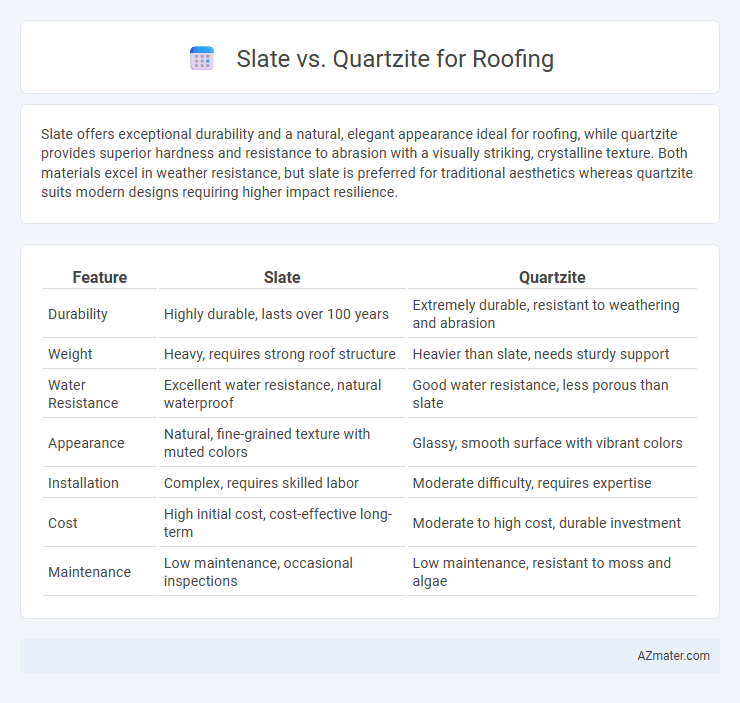Slate offers exceptional durability and a natural, elegant appearance ideal for roofing, while quartzite provides superior hardness and resistance to abrasion with a visually striking, crystalline texture. Both materials excel in weather resistance, but slate is preferred for traditional aesthetics whereas quartzite suits modern designs requiring higher impact resilience.
Table of Comparison
| Feature | Slate | Quartzite |
|---|---|---|
| Durability | Highly durable, lasts over 100 years | Extremely durable, resistant to weathering and abrasion |
| Weight | Heavy, requires strong roof structure | Heavier than slate, needs sturdy support |
| Water Resistance | Excellent water resistance, natural waterproof | Good water resistance, less porous than slate |
| Appearance | Natural, fine-grained texture with muted colors | Glassy, smooth surface with vibrant colors |
| Installation | Complex, requires skilled labor | Moderate difficulty, requires expertise |
| Cost | High initial cost, cost-effective long-term | Moderate to high cost, durable investment |
| Maintenance | Low maintenance, occasional inspections | Low maintenance, resistant to moss and algae |
Introduction to Slate and Quartzite Roofing
Slate roofing consists of natural stone slabs known for durability, fire resistance, and aesthetic appeal, often lasting over a century with minimal maintenance. Quartzite roofing, made from metamorphosed sandstone transformed into a hard, dense stone, offers exceptional strength, weather resistance, and a unique textured appearance that withstands harsh climates. Both materials provide eco-friendly, long-lasting roofing solutions preferred in historic and high-end residential architecture.
Key Characteristics of Slate Roofing
Slate roofing features natural stone slabs renowned for durability, offering a lifespan of 75 to 100 years with exceptional resistance to weathering and fire. Its low water absorption rate and dense composition prevent damage from ice and moisture, making it ideal for harsh climates. Slate's natural variegation and texture provide a unique aesthetic while requiring minimal maintenance compared to alternative roofing materials like quartzite.
Key Characteristics of Quartzite Roofing
Quartzite roofing is renowned for its exceptional hardness and durability, making it highly resistant to weathering and erosion compared to other natural stones. Its dense, non-porous structure provides superior water resistance and minimal absorption, reducing the risk of freeze-thaw damage in colder climates. With a natural glassy sheen and varied color palette ranging from white to gray and pink hues, quartzite offers both aesthetic appeal and long-lasting performance ideal for roofing applications.
Durability Comparison: Slate vs Quartzite
Slate roofing offers exceptional durability with a lifespan of 75 to 100 years, known for its natural resistance to fire, water, and extreme weather conditions. Quartzite, while also highly durable and harder than slate, typically lasts around 50 to 70 years but provides superior resistance to abrasion and impact. Both materials excel in longevity, but slate's proven century-plus performance often makes it the preferred choice for long-term roofing durability.
Aesthetic Appeal and Design Options
Slate roofing offers a natural, elegant aesthetic with its unique, layered texture and range of deep, earthy colors that age beautifully over time. Quartzite provides a strikingly durable surface with a sparkling, crystalline appearance, delivering modern appeal through vibrant color variations and a sleek finish. Both materials enable diverse design options, with slate favoring traditional, rustic styles and quartzite embracing contemporary, high-end architectural looks.
Installation Process and Requirements
Slate roofing installation demands skilled labor due to the stone's brittleness and weight, requiring precise cutting, fitting, and specialized fasteners to prevent cracking. Quartzite, while similarly heavy and durable, allows for slightly easier handling and cutting but still needs robust structural support and experienced roofers for proper alignment and securing. Both materials require reinforced roof framing and waterproof underlayment to ensure long-term performance and avoid leaks.
Maintenance and Longevity
Slate roofing offers exceptional longevity, often exceeding 100 years, with minimal maintenance required due to its natural durability and resistance to weathering. Quartzite, while also durable and visually similar, generally has a shorter lifespan of 40 to 60 years and may require more frequent inspections to prevent potential cracking or discoloration. Both materials benefit from routine cleaning and prompt repair of damaged tiles to maximize their performance and aesthetic appeal.
Cost Analysis: Slate vs Quartzite
Slate roofing typically costs between $10 and $30 per square foot, reflecting its premium durability and aesthetic appeal, while quartzite ranges from $7 to $20 per square foot, offering a more budget-friendly yet resilient option. Installation expenses for slate can reach up to $40 per square foot due to its weight and specialized labor requirements, whereas quartzite installation generally falls between $15 and $25 per square foot. Long-term maintenance and lifespan of slate, often exceeding 75 years, can justify the higher upfront investment compared to quartzite, which offers a lifespan of approximately 40 to 60 years with lower initial costs.
Environmental Impact and Sustainability
Slate roofing offers a natural, durable, and long-lasting option with a low environmental impact due to its extraction from abundant, natural stone deposits and minimal processing requirements. Quartzite, while also durable and natural, often involves more intensive quarrying techniques and energy consumption, which can increase its environmental footprint slightly compared to slate. Both materials are sustainable choices because of their longevity and recyclability, reducing the need for frequent replacement and minimizing landfill waste.
Choosing the Right Material for Your Roof
Slate offers exceptional durability and natural resistance to weather, making it a premium roofing material with a lifespan of over 100 years, while quartzite provides a similarly strong but more cost-effective option with excellent scratch and impact resistance. Choosing the right material depends on factors such as climate, budget, and aesthetic preferences; slate suits historic or high-end projects needing longevity, whereas quartzite fits more modern builds requiring durability with lower maintenance. Both materials are heavy, requiring proper roof structure support and professional installation to maximize performance and lifespan.

Infographic: Slate vs Quartzite for Roofing
 azmater.com
azmater.com